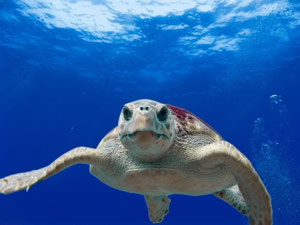S.C. Encyclopedia | The loggerhead turtle (Caretta caretta), a threatened species, was named the state reptile in an act signed by Governor Carroll Campbell on June 1, 1988. Recognizing the loggerhead as “an important part of the marine ecosystem” and that South Carolina’s coastline provides “some of the most pristine nesting areas” for the turtle on the East Coast, the General Assembly declared that the state’s responsibility is “to preserve and protect our wildlife and natural resources.”
 The loggerhead is one of the world’s eight living species of sea turtles and evolved some sixty-five million to seventy million years ago. At birth, hatchlings are about two inches long. Adults can weigh from 200 to 350 pounds, and their carapace, or upper shell, measures from thirty-three to forty inches in length. The animal is yellow and reddish brown and has a distinctive large head—the source of its name—with powerful jaws enabling it to crush clams, crustaceans, and other food. Its great size and hard shell protect the adult turtle from most predators.
The loggerhead is one of the world’s eight living species of sea turtles and evolved some sixty-five million to seventy million years ago. At birth, hatchlings are about two inches long. Adults can weigh from 200 to 350 pounds, and their carapace, or upper shell, measures from thirty-three to forty inches in length. The animal is yellow and reddish brown and has a distinctive large head—the source of its name—with powerful jaws enabling it to crush clams, crustaceans, and other food. Its great size and hard shell protect the adult turtle from most predators.
Adult loggerheads in the western Atlantic range from Newfoundland to Argentina, but they nest in the temperate zones. Breeding occurs in the ocean, and females lay their eggs between May and September. South Carolina beaches are favorite nesting grounds. The female comes ashore at night, lays from eighty to two hundred eggs in her nest, then returns to sea. Eggs and hatchlings are prey to many predators, from ants and crabs to dogs, raccoons, birds, and fish in the sea. Hatchlings must head directly to the ocean, and it is estimated that only one in ten thousand loggerhead eggs makes it to maturity. Dangers to the baby turtles include artificial lights on land, for they may head toward those, instead of seaward, and fall victim to predators. It is believed that it requires twelve to thirty years for loggerheads to reach maturity.
Adult loggerheads are imperiled by collisions with boats and, especially, by being trapped in commercial fishing and shrimping trawl nets, in which they drown if they cannot escape. South Carolinians have been active in working to protect nests and hatchlings, and communities have enacted restrictions on coastal lighting during nesting season. State legislation requires turtle excluder devices (TEDs) on trawl nets in order to protect the species.
– Excerpted from the entry by David C.R. Heisser. To read more about this or 2,000 other entries about South Carolina, check out The South Carolina Encyclopedia by USC Press. (Information used by permission.)



 We Can Do Better, South Carolina!
We Can Do Better, South Carolina!
























